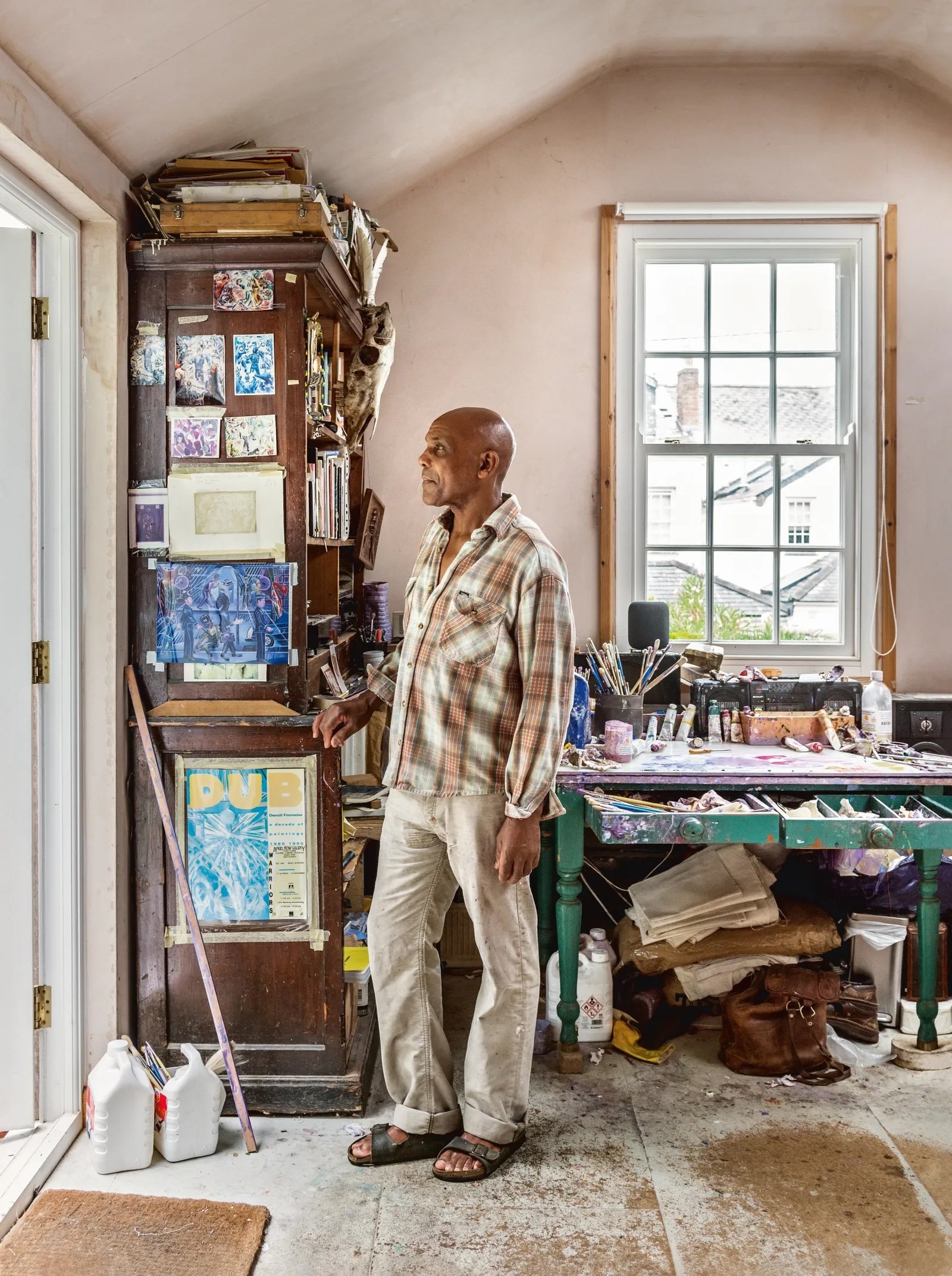Dancing with Color: The Rhythmic Art of Denzil Forrester and the Soul of Urban Life
Denzil Forrester, a Grenadian-born British artist, has earned acclaim for his dynamic and evocative paintings that capture the energy and movement of urban life. Born in 1956 in Grenada, Forrester moved to the UK at a young age, where his experiences of both cultures shaped his artistic vision. Known for his vibrant, large-scale works, he often explores themes of music, culture, and the human condition, reflecting the lived experiences of Black communities in London and beyond.
Denzil Forrester, Stryder, Oil on Canvas, 1985 (Courtesy the Artist and Stephen Friedman Gallery)
Inspirations: Sound, Space, and Social Commentary
Forrester’s work is heavily influenced by the world of music, particularly reggae, dub, and jazz. As a frequent attendee of nightclubs in London during the 1980s, Forrester was inspired by the pulsating rhythms, the movement of bodies on the dance floor, and the vibrant social spaces he inhabited. His art became a way to immortalize the energy of the dancehall scene, creating a visual equivalent of the music that shaped his experience. He would often sketch directly in the clubs, capturing the immediacy of the moment, which would later be transformed into sweeping compositions on canvas.
Forrester’s work also draws from broader social and political themes. As a Black artist navigating the London art scene, his pieces often explore the intersection of race, identity, and urban living. His works serve as both celebration and critique, expressing joy and resistance while addressing issues of inequality and injustice. Forrester's close friend, Winston Rose, a Rastafarian who died in police custody in 1981, became a significant subject in his work, with pieces that highlight the systemic issues faced by Black communities in Britain.
Denzil Forrester, Domino Hunters, Oil on Canvas, 1985 (Private Collection)
Style: Expressive, Rhythmic, and Abstract
Denzil Forrester's style is characterized by bold color palettes, fluid forms, and a sense of rhythm that mirrors the music that inspires him. His paintings often feature abstracted figures in motion, set against swirling backgrounds that convey a sense of dynamism and movement. His approach to composition feels almost musical, with lines and shapes interacting like notes in a jazz improvisation, creating an intense, energetic atmosphere.
Denzil in his purpose-built garden studio at home in Cornwall (Photographed by Joshua Monaghan)
His use of color is another defining feature, with bright, saturated hues that evoke the vibrancy of Caribbean culture, contrasted with the grittier tones of London’s urban landscape. The contrast between these two worlds—one of vibrant celebration, the other of social critique—is central to his work. His paintings are often large, immersive experiences that draw the viewer into the world he portrays.
While rooted in figurative representation, Forrester's work borders on abstraction, as the forms of his subjects are often distorted or exaggerated to emphasize movement and emotion. The interplay of light and shadow, combined with a loose, gestural painting technique, lends a sense of immediacy to his pieces, as though capturing a fleeting moment in time.
Recognition and Legacy
Denzil Forrester’s work has been celebrated internationally, and his influence on contemporary British art is profound. In recent years, his contributions have gained broader recognition, with his works being exhibited at major galleries, including the Tate Britain and the Studio Museum in Harlem. His paintings not only document a particular time and place but also transcend those boundaries to speak to universal themes of movement, culture, and identity.
Forrester’s art continues to resonate because it speaks to the human experience in a way that is both personal and political. His ability to convey the intensity of life in urban spaces, while also highlighting the deeper social issues within those spaces, has cemented his place as a vital figure in contemporary art. His works stand as a testament to the power of art to capture the rhythms of life and to challenge the viewer to see beyond the surface.
In a world increasingly aware of the need for diverse voices in art, Denzil Forrester’s vibrant, expressive canvases provide a powerful, necessary perspective—one that pulses with the energy of the streets, the heartbeat of music, and the ever-present quest for justice.
Denzil Forrester, Three Wicked Men, Oil on canvas, 1982 (Tate London)
In this painting, Forrester captures a dancehall scene filled with movement and life, yet there's an unsettling presence—the police, represented by three ominous figures. Their towering presence beside the sound system reflects the intrusion of state power into these cultural spaces. The police aren’t just observers; they are symbols of control and repression, standing as watchmen while also pulling revelers away from the space of freedom and expression.
"Three Wicked Men" speaks to the tensions between joy and oppression, culture and authority. It’s a visual reminder of how Black communities were forced to navigate a constant tension between celebration and surveillance. Forrester uses his energetic style and bold, rhythmic colors to reflect the vibrancy of Black culture while also illustrating the heavy weight of social injustices that persisted in those same spaces. This work is a critique of the policing of Black bodies and a call to acknowledge the social inequities that permeated life at the time.
The painting is a brilliant blend of political and personal, capturing both the essence of cultural vibrancy and the struggle against institutionalized racism.





